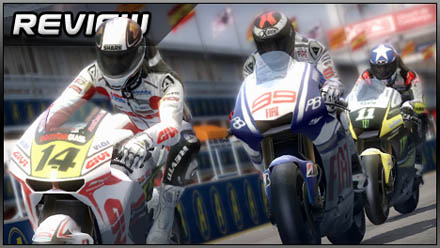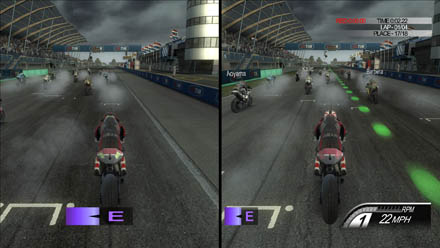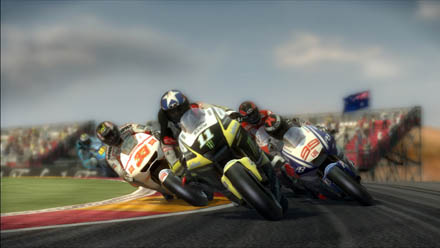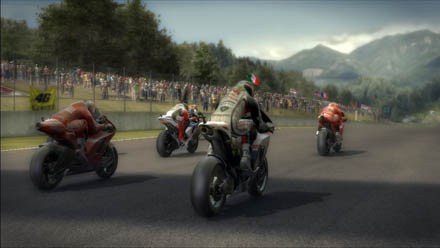
Motorbike games are a tricky breed. In a sport with a niche fan base, developers of these titles face a host of decisions to make as they seek a game that will appeal to both the sports key fans and wider market. Getting this balance right is crucial as Capcom realised when they gained the production rights of the franchise in ’08, now in its third year we delve deeper in discovering what makes Moto GP 10/11 a title contender.
A highly polished opening shows a flurry of riders racing furiously whilst a pumping techno soundtrack overlays the roar of the engines. Teams, drivers, bikes have all been meticulously scrutinised in order to make sure they stay as true to the sport as possible. Monumental games have given a rigid attention to detail while making sure the game strikes a quite elegant balance between arcade and simulation.

Start your first race immediately the rider’s movement is completely in sync with the on screen performance: the gradual but full tilt of a rider’s knee as you glide round corners, to the reflex movements of an arm as the shock is absorbed from a change in surface. This 60fps graphical detail is supported with an updated physics engine making a clean approach crucial to getting cornering right, under-steer and the bike will react accordingly. Positioning of the rider must be taken into account and it’s great to see how this emphasis teaches the player the need for different riding styles depending on the type of corner encountered.
Though its not all plain sailing, there are times where I have caught the edge of the rumble strip, still feeling perfectly under control, or another driver has just touched me slightly only to see my bike sent flailing off the track. Of course crashes for all new players should be expected, the resulting smashes yielding some fantastic wincing moments.
Controls provide you with independent front and rear brake and a tuck in button to reduce drag on the straights. Although in theory a simplistic layout the use of these still provides a stiff learning curve. Heavy handed gamers will find movement initially difficult, a slight knock of the control stick will see them swerving manically from side to side making crashing inevitable. More so than this the front brake doesn’t feel anywhere near responsive enough. Even braking well before an upcoming turn the reaction from the brake doesn’t seem to match yours leading to an over reliance of the rear control slowing you down to much reduced speeds in key areas where you want to be closing the gap on your opponents. As if almost pre-empting this criticism the game has given you a far greater level of control over fine-tuning. Even mid race a player can pause to edit the gear differential, tyre compound or suspension feel before heading straight back into action.
However if the challenge is too steep a number of different assistance tools that can be tailored to suit your needs, these include gear ratios, weight transfer, traction control amongst other options. A racing line is also on hand indicating suggested speeds and position for navigating the track, however after extensive playing it would appear that players will need to brake a lot earlier than suggested, making it pretty useless for newcomers. The racing line offers default and personal options, the latter creating a line based on your personal style, trouble is by the time you create a line worth following, you probably won’t need a line at all! The second chance feature also makes a happy return, allowing the option to rewind time, for those moments when you skid off at the last corner; it gives a chance to correct your incident without having to replay the whole lap again. Constant use will drain your final ranking especially in the season modes so it really should only be used as a last resort. Strangely though, these niggles however irritating do provide you with motivation while mastering the manual controls will save fractions of seconds, helping improve on that personal best.

For the simulation lovers the ‘Career Mode’ is superb. The balancing of staff, upgrades, and research are as crucial to a successful season as winning races. Clean driving is rewarded with an increased recognition earning more money, better parts, and allowing for a bike customised as personal to the players racing style as possible. Race length can be tailored from 3 to 99 laps while local co-op has been added to allow for a second player to drop in and out of your session when it suits them. Next is the ‘World Championship’ mode allowing players to jump into the upcoming season as any of the riders or teams competing, 2011 DLC will follow in the coming months.
Time Trial and Challenge modes are where the arcade fans will spend most of their time, focus is shifted purely on speed and style. Time trail does what it says on the tin while Challenge mode is easily the most addictive of the lot, pitting you against the clock with a goal of completing races in a ridiculously short timeframe, extra seconds are earned by good driving technique and the odd bit of showboating in an effort to not only complete a race before the clock runs out but with more time than you started, online leader boards for this mode will be a quest for many gamers I’m sure.

Multiplayer mode is great fun. The naturally fast paced nature that motor bike racing brings, combined with the new physics engine approach to cornering allows for some nail biting exchanges. Where in the early stages of career modes you may be restricted to overtaking on corners due to acceleration issues, the lead exchanges are fast and frantic. Racing against a friend at full speed trying to get the tilt advantage on a lap makes this mode endlessly replayable.
MotoGP 10/11 is an impressive title; a new physics engine and attention to detail have defiantly pushed the game on in the immersion stakes, however a sometimes imprecise control system hinders this. Moto GP has successfully blurred the line between arcade and simulation while providing a great option to people who enjoy the sport but don’t necessarily feel they have to learn to ride a bike, just to play the game.







 Satoru Iwata Video Interview - the late Nintendo president spoke with Kikizo in 2004 as 'Nintendo Revolution' loomed.
Satoru Iwata Video Interview - the late Nintendo president spoke with Kikizo in 2004 as 'Nintendo Revolution' loomed. Kaz Hirai Video Interview - the first of Kikizo's interviews with the man who went on to become global head of Sony.
Kaz Hirai Video Interview - the first of Kikizo's interviews with the man who went on to become global head of Sony. Ed Fries Video Interview - one of Xbox's founders discusses an epic journey from Excel to Xbox.
Ed Fries Video Interview - one of Xbox's founders discusses an epic journey from Excel to Xbox. Yu Suzuki, the Kikizo Interview - we spend time with one of gaming's most revered creators.
Yu Suzuki, the Kikizo Interview - we spend time with one of gaming's most revered creators. Tetris - The Making of an Icon: Alexey Pajitnov and Henk Rogers reveal the fascinating story behind Tetris
Tetris - The Making of an Icon: Alexey Pajitnov and Henk Rogers reveal the fascinating story behind Tetris Rare founders, Chris and Tim Stamper - their only interview? Genuinely 'rare' sit down with founders of the legendary studio.
Rare founders, Chris and Tim Stamper - their only interview? Genuinely 'rare' sit down with founders of the legendary studio. The History of First-Person Shooters - a retrospective, from Maze War to Modern Warfare
The History of First-Person Shooters - a retrospective, from Maze War to Modern Warfare